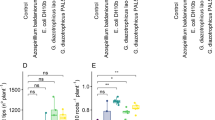Abstract
The phytotoxic or promoting effect of bacterial secretions on root growth of young lettuce seedlings (Lactuca sativa) was measured under axenic conditions. It was assumed that the inhibitory or promoting effects of either deleterious rhizobacteria (DRB) or of plant growth promoting rhizobacteria (PGPR) were auxin mediated. To avoid measurements of either parasitism or competition, seedlings were placed adjacent to bacterial colonies, with no contact between the organisms. Auxin excretion rate, evaluated by thin-layer chromatography (TLC) combined with Salkowski's reagent, indicated that all bacteria examined produced and released indole-3-acetic acid (IAA). High levels of IAA (76.6 μM) were excreted by four DRB (Micrococcus luteus, Streptoverticillium sp., Pseudomonas putida, and Gluconobacter sp.) during 84 hr of incubation. High concentrations of IAA released by DRB accounted for the suppression of root growth. Other unidentified fractions in the eluates of DRB also inhibited root elongation, but to a lesser extent. Like DRB, four isolates of PGPR (Agrobacterium sp., Alcaligenes piechaudii, and two different strains of Comamonas acidovorans) secreted IAA, but at lower levels (16.4 μM during a similar period of incubation). PGPR secreted growth promoting substances other than IAA, and these are now being investigated.
Similar content being viewed by others
REFERENCES
Bakker, P. A. H. M., Bakker, A. W., Marugg, J. D., Weisbeek, P. J., and Schippers, B. 1987. A bioassay for studying the role of siderophores in potato growth stimulation by Pseudomonas spp. in short potato rotation. Soil Biol. Biochem. 19:443-450.
Caesar, A. J., and Burr, T. J. 1987. Growth promotion of apple seedlings and rootstocks by specific strains of bacteria. Phytopathology 77:1583-1588.
Catska, V., Vancura, V., Hudska, G., and Prikryl, Z. 1982. Rhizosphere microorganisms in relation to the apple replant problem. Plant Soil 69:187-197.
Chanway, C. P., and Holl, F. B. 1993. Ecological growth response specificity of two Douglas-fir ecotypes inoculated with coexistent beneficial rhizosphere bacteria. Can. J. Bot. 72:582-586.
Ehmann, A. 1977. The van Urk-Salkowski reagent—a sensitive and specific chromogenic reagent for silica gel thin-layer chromatographic detection and identification of indole derivatives. J. Chromatogr. 132:267-276.
Gamliel, A., and Katan, J. 1991. Involvement of fluorescent pseudomonads and other microorganisms in increased growth response of plants in solarized soils. Phytopathology 81:494-502.
Glick, B. R., Jacobson, C. B., Schwarze, M. M. K., and Pasternak, J. J. 1994. 1-Aminocyclopropane-1-carboxylic acid deaminase mutants of the plant growth promoting rhizobacterium Pseudomonas putida GR12-2 do not stimulate canola root elongation. Can. J. Microbiol. 40:911-915.
Kaminsky, R. 1981. The microbial origin of the allelopathic potential of Adenostoma fasiculatum H&A. Ecol. Monogr. 51:365-382.
Katz, D. A., Sneh, B., and Friedman, J. 1987. The allelopathic potential of Coridothymus capitatus L. (Labiatae). Preliminary studies on the roles of the shrub in the inhibition of annuals germination and/or to promote allelopathically active actinomycetes. Plant Soil 98:53-66.
Kato-Noguchi, H., Mizutani, J., and Hasegawa, K. 1994. Allelopathy of oats II Allelochemical effect of L-tryptophan and its concentration in oat root exudates. J. Chem. Ecol. 20:315-319.
Kloepper, J. W., Zablotowivz, R. M., Tipping, E. M., and Lifshitz, R. 1990. Plant growth promotion mediated by bacterial rhizosphere colonizers, pp. 315-326, in D. L. Keister and P. B. Cregan (eds.). The Rhizosphere and Plant Growth. Kluwer Academic, Dordrecht.
Loper, J. E., and Schroth, M. N. 1986. Influence of bacterial source of indole-3-acetic acid on root elongation of sugar beet. Phytopathology 76:386-389.
Meharg, A. A., and Killham, K. 1995. Loss of exudates from the roots of perennial ryegrass inoculated with a range of micro-organisms. Plant Soil 170:345-349.
Patten, C. L., and Glick, B. R. 1996. Bacterial biosynthesis of indole-3-acetic acid. Can. J. Microbiol. 42:207-220.
Rechcigl, M., Jr. 1978. CRC Handbook Series in Nutrition and Food, Section G: Diets, Culture Media, Food Supplements, Volume III Culture Media for Microorganisms and Plants. CRC Press, Boca, Raton, Florida.
Sarwar, M., and Kremer, R. J. 1995. Enhanced suppression of plant growth through production of L-tryptophan-derived compounds by deleterious rhizobacteria. Plant Soil 172:261-269.
Sasser, M. 1990. Identification of bacteria through fatty acid analysis, pp. 194-204, in Z. Klement, K. Rudolf, and D. Sands (eds.). Methods in Phytobacteriology. Akademiai Kiado, Budapest.
Schippers, B., Bakker, A. W., and Bakker, P. A. H. M. 1987. Interactions of deleterious and beneficial rhizosphere microorganisms and the effect of cropping practices. Annu. Rev. Phytopathol. 25:339-358.
Waschkies, C., Schropp, A., and Marschner, H. 1994. Relations between grapevine replant disease and root colonization of grapevine (Vitis sp.) by fluorescent pseudomonads and endomycorrhizal fungi. Plant Soil 162:219-227.
Xie, H., Pasternak, J. J., and Glick, B. R. 1996. Isolation and characterization of mutants of the plant growth promoting rhizobacterium Pseudomonas putida GR12-2 that overproduce indoleacetic-acid. Curr. Microbiol. 32:67-71.
Yoshikawa, M., Hirai, N., Wakabayashi, K., Sugizaki, H., and Jwamura, H. 1993. Succinic and lactic acids as plant growth promoting compounds produced by rhizospheric Pseudomonas putida. Can. J. Microbiol. 39:1150-1154.
Author information
Authors and Affiliations
Rights and permissions
About this article
Cite this article
Barazani, O., Friedman, J. Is IAA the Major Root Growth Factor Secreted from Plant-Growth-Mediating Bacteria?. J Chem Ecol 25, 2397–2406 (1999). https://doi.org/10.1023/A:1020890311499
Issue Date:
DOI: https://doi.org/10.1023/A:1020890311499




